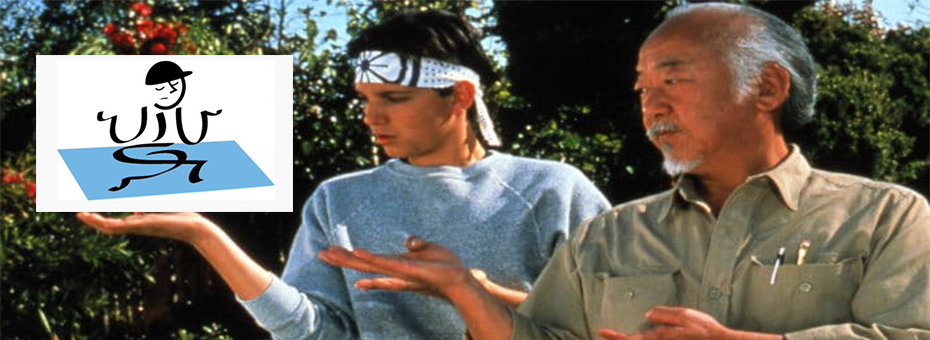Have you had a chance to catch Cobra Kai, Netflix’s latest hit show? The premise is brilliant. It takes up the Karate Kid storyline 30 years later from the perspective of the villain, Johnny Lawrence, the high school bully who pushed the Karate Kid’s teenage hero, Daniel Larusso, to learn traditional Okinawa Karate from the ultimate sensei, Mr. Miyagi.
The show continues to focus on the original characters. Johnny Lawrence is down on his luck, an angry bitter failure both professionally and as a parent, and reconstruct his life by resuscitating the “Cobra Kai” dojo – which brings a horrified Daniel Larusso into the game. But, with his sensei now deceased, the character has lost his moral compass and gets pulled into a cycle of violence that he is helpless to stop. It’s like watching the karate version of Bad Santa – the central concept is … bad sensei. It’s worth watching now, for you will receive a touching reminder of how to coach another in a foreign set of ideas with great applicability for today’s challenges.
Lean is a response to a challenge that seemed obvious back in the day: how to improve performance by improving the connection, skills, and engagement of everyone so as to create better outcomes for the company and society at large?The show is great fun, my kids love it and it prompted us to re-watch the original Karate Kid flick together. Now, that movie is a gem. No bad scenes, memorable characters, touching moments (the sensei character is an American war hero who’s family was incarcerated at Manzanar). The movie’s greatest gimmick is teaching karate through doing housework: cleaning cars (wax on, wax off), sanding floors (right circle, left circle), painting fences (up, down, up, down): teaching the body the essential moves of karate. It captured the imagination of a generation, and defined the image of what a “sensei” looks like – a term that then migrated into the lean language. The years have barely diminished the pleasure of watching it again, and, curiously, in these days of electing bullies around the world, the core intrigue sadly resonates – when will people realize authoritarian leaders are simply bad news?
Teaching a Timeless Set of Values
Watching it as an adult, however, it struck me that the nostalgia it evoked was not just about earlier days. Things have changed. At the time, the movie perfectly captured our discovery of, and infatuation with, Japan. My father had started going to Japan regularly ten years before the movie came out. He tried to learn the language (he is still trying, actually. Last time we went to Japan he spent two weeks in a language class). He took up Karate and dragged me to the lessons every week. He found a sensei who, in retrospect, was very much a French Mr. Miyagi – in love with the deeper concepts of budo. As it says in the movie, I was (supposedly) taught to fight (hated every moment of it) in order…to not have to fight. But what about now, I wondered. I loved it again and got caught up in what the writer and director wanted to convey. But what, I wondered, were the values they were portraying back then that felt so captivating?
The explicit values portrayed in the film are:
- Balance: Good balance is the key to victory in a fight, but more importantly, practice to find balance in life, which is stated as one’s ultimate life purpose.
- Use your head: Repeatedly, the sensei exhorts the student to use his head, not his gut, to figure things out. He also demonstrates clear thinking in getting out of sticky situations without having to fight (as a storyline, this has limits, but the point is stressed time and time again).
- Connections: The film conveys a sense of deep bonding, in the sensei-student relationship, but also in the mother-son relationship, as well as, of course, a summer of young love.
- The importance of attitude and responsibility: “no such thing as a bad student, only bad teacher” is the surprising moral of the story – look to the source of the problem, the attitudes and the role models, beyond the behavior.
- Competence: Of course, learning new skills through repeated effort, from punching to driving or bonsai pruning, opens up new possibilities, new options, and new ways to improve one’s situation. Precision through practice is the key to succeeding against the odds.
- Inner beauty: Finally, one key feature that makes the film so attractive is its depiction of inner, hidden beauty: the local handyman’s tool shed is in fact a bonsai nursery. In the middle of a dump you find this lovely traditional Japanese home. And in the midst of its zen garden, on a derelict stump, the sensei practices the beautiful crane technique no one is supposed to see. While beauty is ever present in the film, this is not show-off beauty; this is peaceful, hidden, cherry blossom beauty that is cultivated for its own sake and not for display or profit.
These values, I believe, resonate with all the old-style lean practitioners. Indeed, they echo closely the values of the Toyota Way: Go and see, Challenge, Kaizen, Respect and Teamwork.
What struck me most is that these values seem to have disappeared from the current discourse. You won’t find them on LinkedIn or on your twitter feed. The chatter there is all about growth hacking, or complaining about this or that intolerable action of one celebrity or other. It’s all about purchasing apps for quick results to enhance your life without having to think about why, how or what. It’s all about now, now, the short time of response, and not the long time of deliberation, practice and learning.
Lean is a response to a challenge that seemed obvious back in the day: How to improve performance by improving the connection, skills, and engagement of everyone so as to create better outcomes for the company and society at large? How to better align individual fulfilment and corporate destiny so that all benefit? Lean was one way to do so. It never occurred to me that the questions itself could vanish.
Today, corporations use zero-interest rates loans to buy back their own shares in order to raise share price. Activist shareholders argue that the only thing to do is increase revenue and reduce expenses at every opportunity and all will be well. The only thing that matters is shareholder value. IT and AI offer ever-expanding means of engineering processes so that employees have less and less latitude in their jobs, and many companies have responded to people working at home because of the pandemic by upping their monitoring and control techniques. Monetization is the name of the game.
And monetization is the only value I hear discussed in companies these days. Forget about balance, or customer relationships, or honing new skills or acquiring new ones. Increase revenues or reduce expenses are the only two opportunities I hear about. Customers complain? No matter as long as they pay. One client account represents 85 percent of our business. How is it a problem? look at the fees we rake in. People are unhappy? So? They’re getting paid, aren’t they? The product is less than it could be? We’re within budget. As social psychologist Amy Cuddy notes, “listening” is no longer about taking the other person’s point on board and building on it, but about acknowledging and moving on to what you already planned to do.
Improving Things Beyond Monetization
Not only is this a sad and joyless way to work, but the irony is that it doesn’t ultimately deliver. Narrow-minded and short-sighted thinking leads to inevitable accidents, catastrophes and disasters that cost fortunes to mop up and further damage morale. It has become okay to finger-point endlessly and claim the leak is on their side of the boat – without any awareness that we’re all sinking together for lack of trying.
The unexpected wake-up call of the modest perfection of the original Karate Kid movie was that we need to move beyond defending this or that method of work and look to highlight opportunities of improving things beyond monetization. Improving balance. Improving thinking and seeking smarter solutions. Improving connections. Improving attitudes. Improving skills. Improving inner beauty. None of these are about making a little more or a little less money at month end – but they are about enhancing our lives, and through our connections to each other, our society as a whole. We know how to grow flowers and raise kids, and build companies. We need to remind ourselves these are valid purposes in themselves, by themselves, for themselves. Wax on, wax off, breathe in, breathe out.







i love it